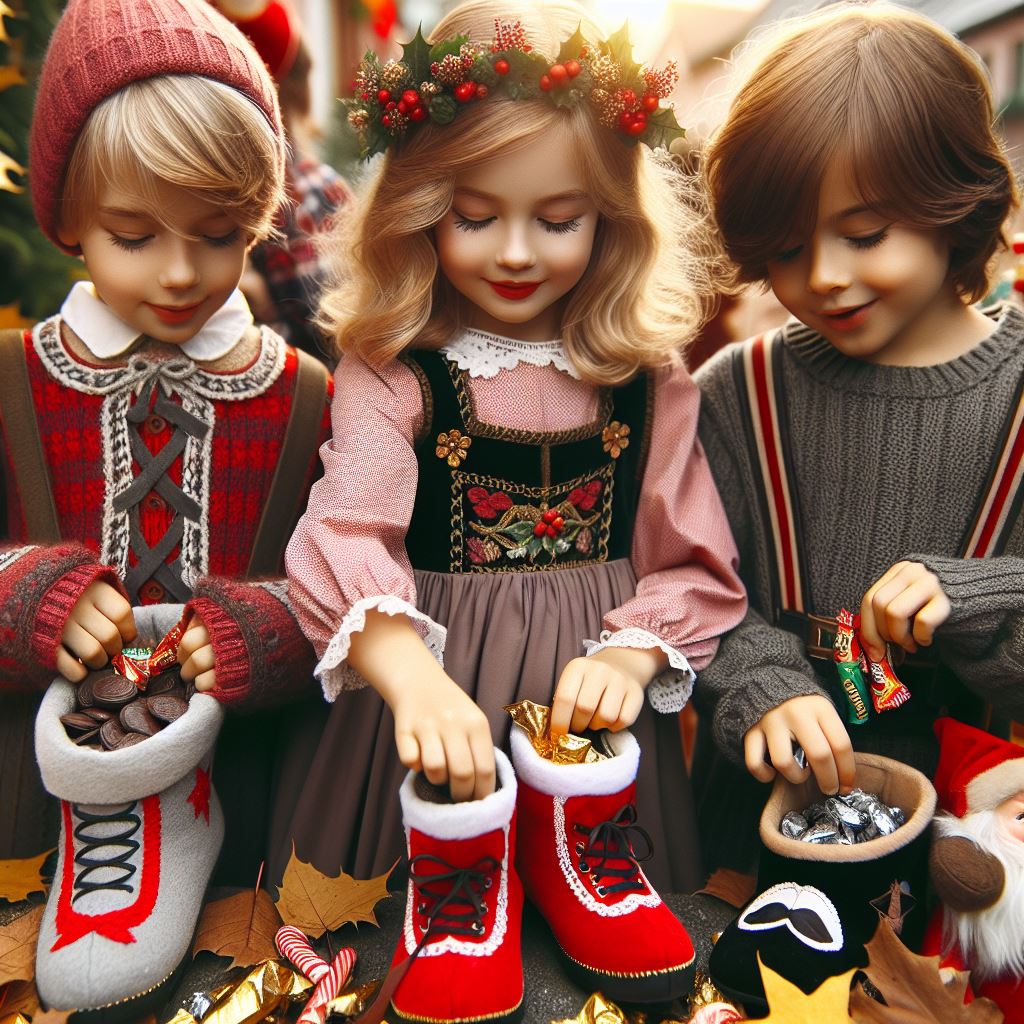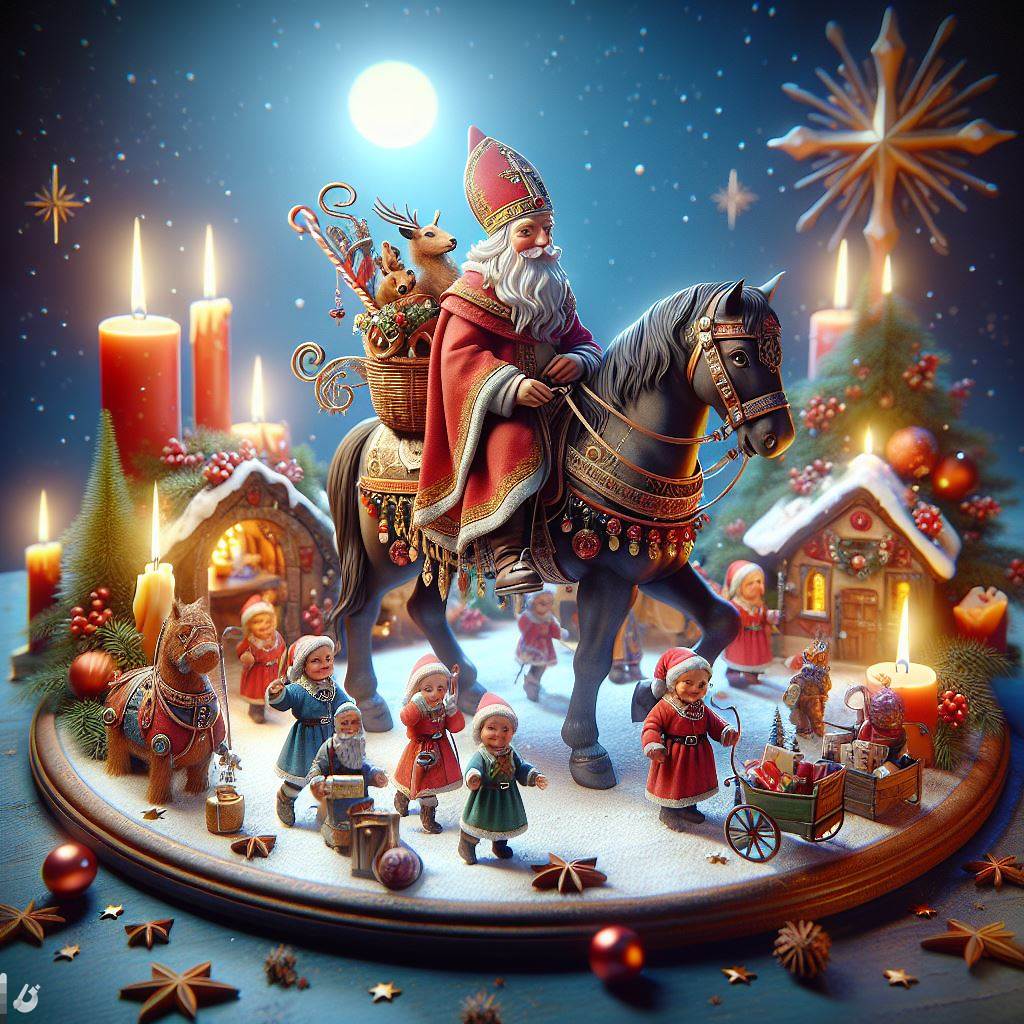Jolly Old St. Nicholas: December 6th – A Whimsical Journey into Germany’s St. Nicholas Day Traditions
GERMAN HERITAGE USA | AFFILIATE DISCLAIMER: This post may or may not contain affiliate links which means we may receive a commission for purchases made through links. We will only recommend products that we have personally used or that we truly trust. Learn more on our Private Policy and Disclaimer Page located under our Terms Of Service tab above.
Ah, the twinkling lights, the scent of cinnamon in the air, and the joyful anticipation of the holiday season – it’s that magical time of year again in Germany! But wait, why are the children polishing their boots and leaving them outside on the evening of December 5th? What’s the deal with St. Nicholas, and how does he differ from the familiar Santa Claus we know and love? Join us on a delightful journey as we unwrap the traditions of St. Nicholas Day in Germany.

The Man Behind the Beard: Who is St. Nicholas?
Before we dive into the festivities, let’s meet the man of the hour – St. Nicholas. Born around 245 C.E. in what is now Turkey, this Greek Christian bishop became renowned for his miracles and secret gift-giving. Fast forward to December 6th, the day Germans commemorate his passing in 346. St. Nicholas is the patron saint of little children, sailors, merchants, and students – a true festive multitasker!

Shoes Out, Spirits High: The Night Before St. Nicholas Day
Picture this: it’s the evening of December 5th, and children across Germany are carefully placing their polished boots outside their doors. But why? Well, the historical St. Nicholas had a knack for leaving surprises, like coins, in people’s shoes overnight. According to a Statista infographic, a whopping 99 percent of Germans eagerly await St. Nicholas to fill their boots with treats.
Before the magic happens, there’s a bit of preparation involved. Children not only leave their boots but also ensure they are polished to perfection. It’s not just about receiving gifts; it’s a subtle way for kids to showcase their good behavior. And here’s a pro-tip: one boot per child is the norm to avoid appearing too greedy. Check, one polished boot – now what?

Legend has it that St. Nicholas makes a grand entrance in the middle of the night, riding on a donkey or a horse. He leaves behind an array of delightful treats – coins, chocolate, oranges, and toys – for the well-behaved children. But what about the naughty ones? Ah, that’s where family traditions come into play.
In some families, St. Nicholas is accompanied by the mysterious Knecht Ruprecht, his not-so-friendly sidekick. This sinister-looking figure may question children about their behavior, and the consequences for the naughty ones vary. Some might find a switch in their boot, while others could face a pretend spanking with a rod. The YouGov survey reveals that 51 percent of respondents believe Knecht Ruprecht is part of the Nikolaus tradition, adding a touch of mystery and mischief to the festivities.
Santa’s Not Coming to Town: St. Nicholas vs. Christmas Eve
Hold on to your stockings – St. Nicholas and Santa Claus are not one and the same! While St. Nicholas spreads cheer on December 6th, Santa Claus, or the Weihnachtsmann, usually makes a grand entrance on the afternoon of Christmas Eve. It’s a double dose of holiday joy for German children!

A Trip Down Memory Lane: The Historic St. Nicholas
As we unravel the layers of German Christmas customs, it’s crucial to take a trip down memory lane. St. Nicholas, the historic figure from the 4th century, has paved the way for various Santa Clauses with different names across German-speaking regions. From Belsnickle to Niglo, the festive landscape is as diverse as the regional dialects themselves.
Protestant vs. Catholic: A Yuletide Tug of War
In the intricate tapestry of German Christmas customs, the tussle between Protestant and Catholic traditions adds an extra layer of complexity. Martin Luther’s desire to replace St. Nicholas with the Christkindl in Protestant regions created a ripple effect, ultimately giving rise to the Weihnachtsmann. The Christkindl, initially Protestant, now reigns supreme in Catholic regions – a festive paradox indeed!

Conclusion: Frohen Nikolaus!
And there you have it – a whirlwind tour of St. Nicholas Day in Germany, where polished boots, mysterious companions, and a touch of festive mischief reign supreme. So, as December 6th approaches, let the children polish their boots, embrace the magic of St. Nicholas, and revel in the joyous spirit of the holiday season.
Frohen Nikolaus to one and all!

